Business and Finance: Statistical Analysis of Boeing, IBM, and S&P 500
VerifiedAdded on 2020/03/28
|14
|1904
|30
Homework Assignment
AI Summary
This assignment provides a comprehensive statistical analysis of Boeing and IBM stocks, along with the S&P 500 index, covering the period from July 2010 to December 2015. It includes the computation of monthly gains, summary statistics, and hypothesis testing for normality using the Jarque-Berra test. The assignment conducts t-tests to assess claims about Boeing's returns and F-tests to compare the risks associated with the two stocks. It further compares returns using t-tests, evaluates stock performance for investment decisions, and applies the CAPM model, including beta analysis and regression output interpretation. The document also provides an interpretation of stock movements over time, assesses risk and return characteristics, and analyzes the model's explanatory power through R2. Finally, it examines the normality of error terms via probability plots and draws conclusions on stock performance and investment suitability based on the statistical findings.
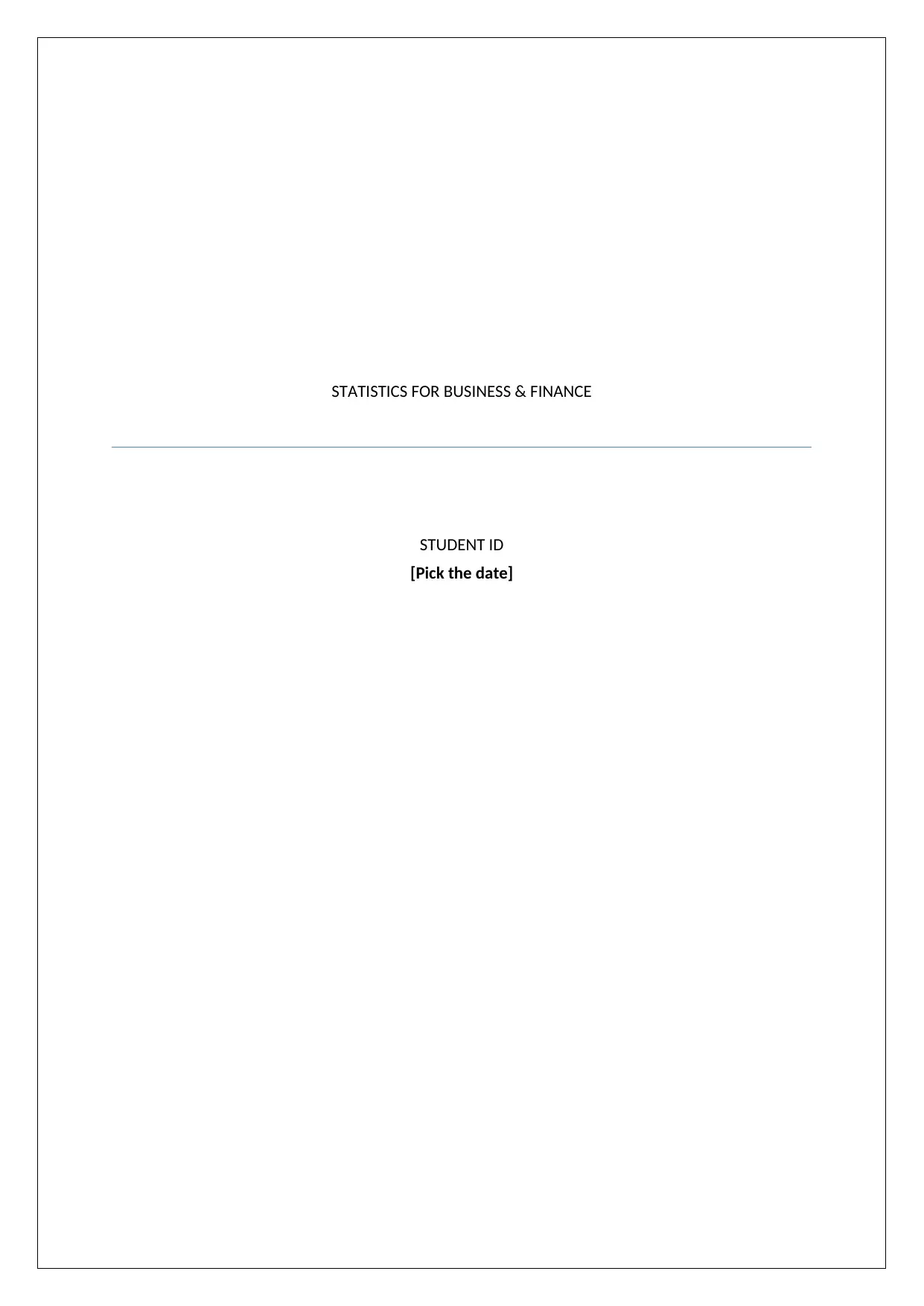
STATISTICS FOR BUSINESS & FINANCE
STUDENT ID
[Pick the date]
STUDENT ID
[Pick the date]
Paraphrase This Document
Need a fresh take? Get an instant paraphrase of this document with our AI Paraphraser
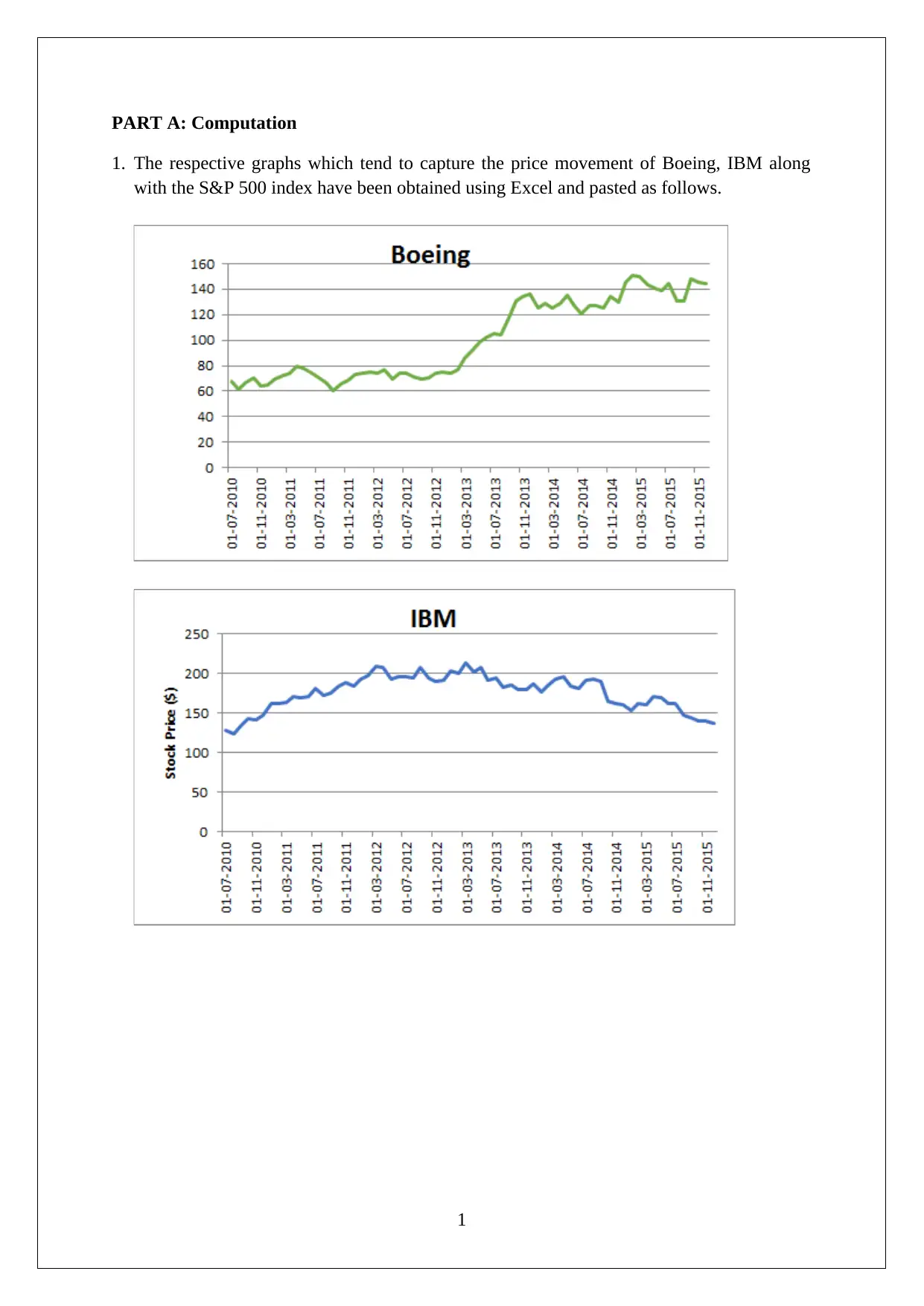
PART A: Computation
1. The respective graphs which tend to capture the price movement of Boeing, IBM along
with the S&P 500 index have been obtained using Excel and pasted as follows.
1
1. The respective graphs which tend to capture the price movement of Boeing, IBM along
with the S&P 500 index have been obtained using Excel and pasted as follows.
1
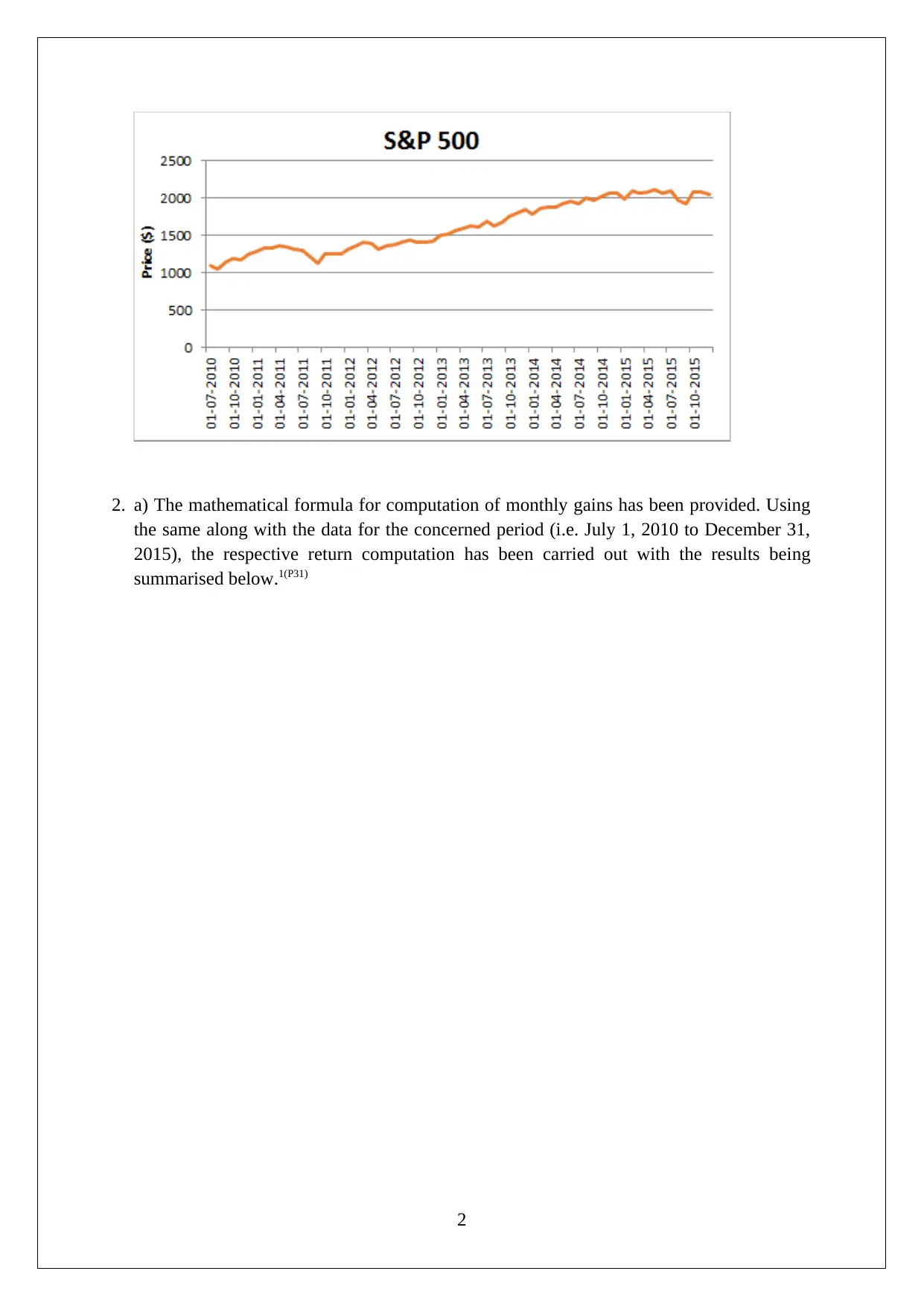
2. a) The mathematical formula for computation of monthly gains has been provided. Using
the same along with the data for the concerned period (i.e. July 1, 2010 to December 31,
2015), the respective return computation has been carried out with the results being
summarised below.1(P31)
2
the same along with the data for the concerned period (i.e. July 1, 2010 to December 31,
2015), the respective return computation has been carried out with the results being
summarised below.1(P31)
2
⊘ This is a preview!⊘
Do you want full access?
Subscribe today to unlock all pages.

Trusted by 1+ million students worldwide
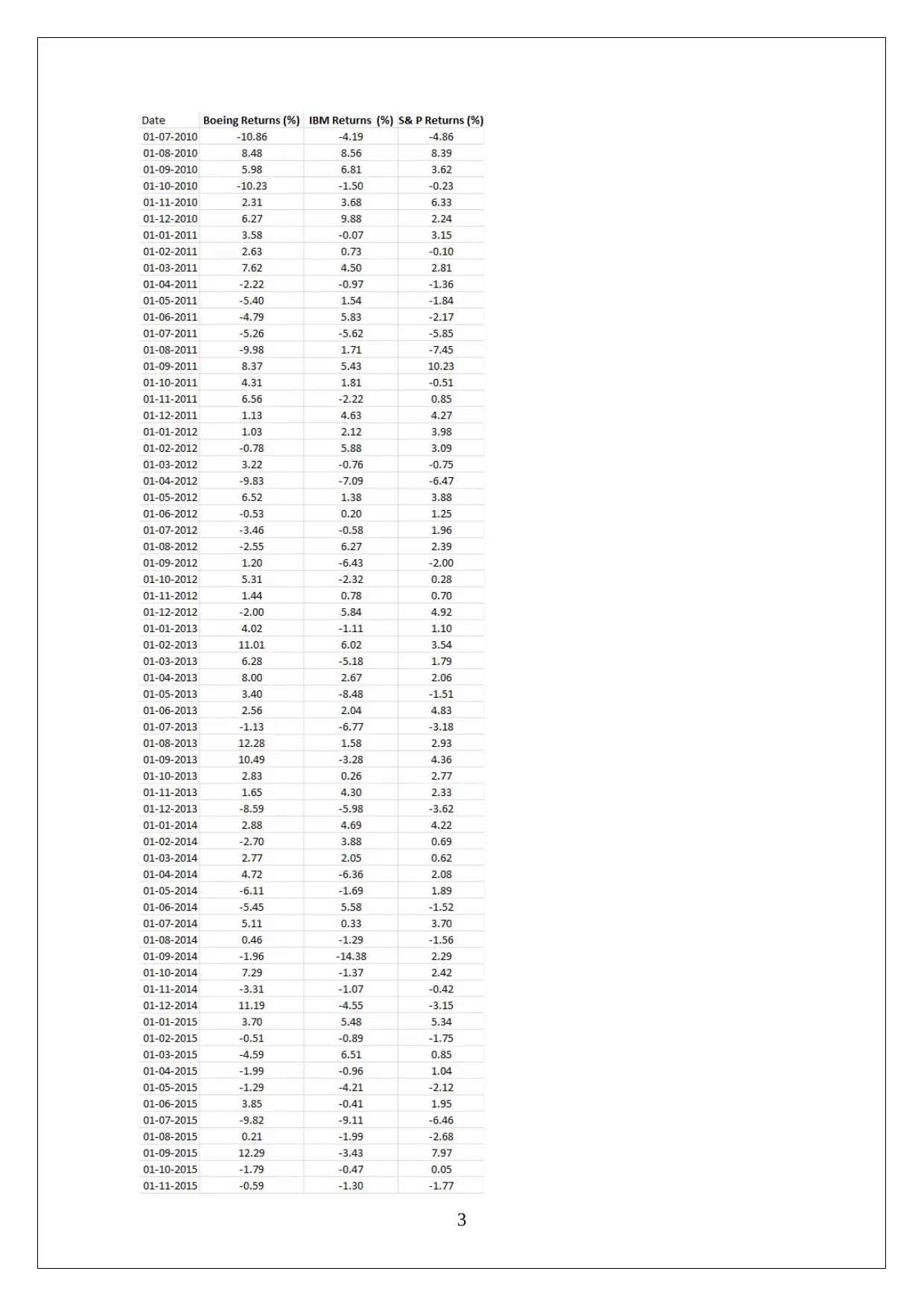
3
Paraphrase This Document
Need a fresh take? Get an instant paraphrase of this document with our AI Paraphraser
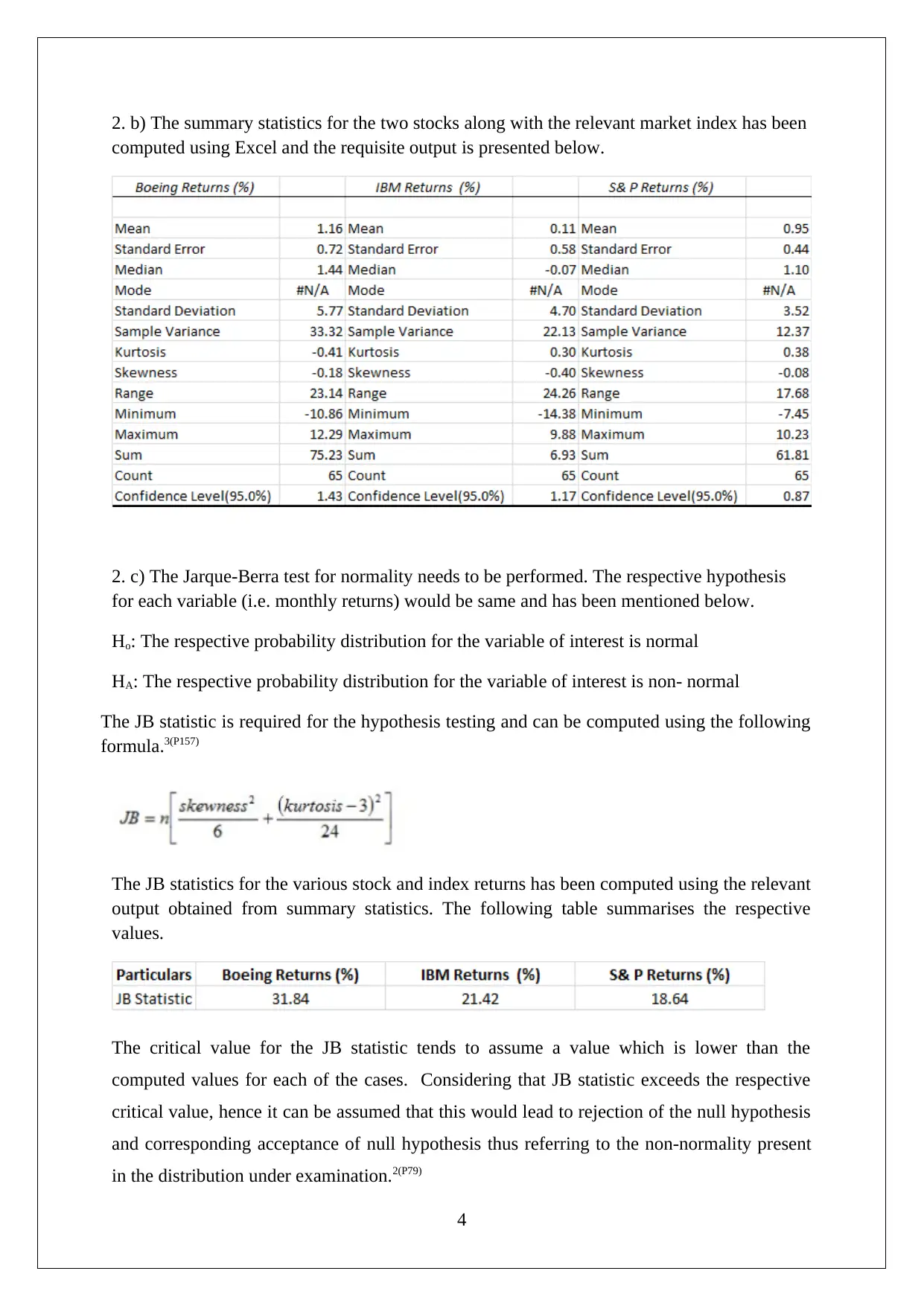
2. b) The summary statistics for the two stocks along with the relevant market index has been
computed using Excel and the requisite output is presented below.
2. c) The Jarque-Berra test for normality needs to be performed. The respective hypothesis
for each variable (i.e. monthly returns) would be same and has been mentioned below.
Ho: The respective probability distribution for the variable of interest is normal
HA: The respective probability distribution for the variable of interest is non- normal
The JB statistic is required for the hypothesis testing and can be computed using the following
formula.3(P157)
The JB statistics for the various stock and index returns has been computed using the relevant
output obtained from summary statistics. The following table summarises the respective
values.
The critical value for the JB statistic tends to assume a value which is lower than the
computed values for each of the cases. Considering that JB statistic exceeds the respective
critical value, hence it can be assumed that this would lead to rejection of the null hypothesis
and corresponding acceptance of null hypothesis thus referring to the non-normality present
in the distribution under examination.2(P79)
4
computed using Excel and the requisite output is presented below.
2. c) The Jarque-Berra test for normality needs to be performed. The respective hypothesis
for each variable (i.e. monthly returns) would be same and has been mentioned below.
Ho: The respective probability distribution for the variable of interest is normal
HA: The respective probability distribution for the variable of interest is non- normal
The JB statistic is required for the hypothesis testing and can be computed using the following
formula.3(P157)
The JB statistics for the various stock and index returns has been computed using the relevant
output obtained from summary statistics. The following table summarises the respective
values.
The critical value for the JB statistic tends to assume a value which is lower than the
computed values for each of the cases. Considering that JB statistic exceeds the respective
critical value, hence it can be assumed that this would lead to rejection of the null hypothesis
and corresponding acceptance of null hypothesis thus referring to the non-normality present
in the distribution under examination.2(P79)
4
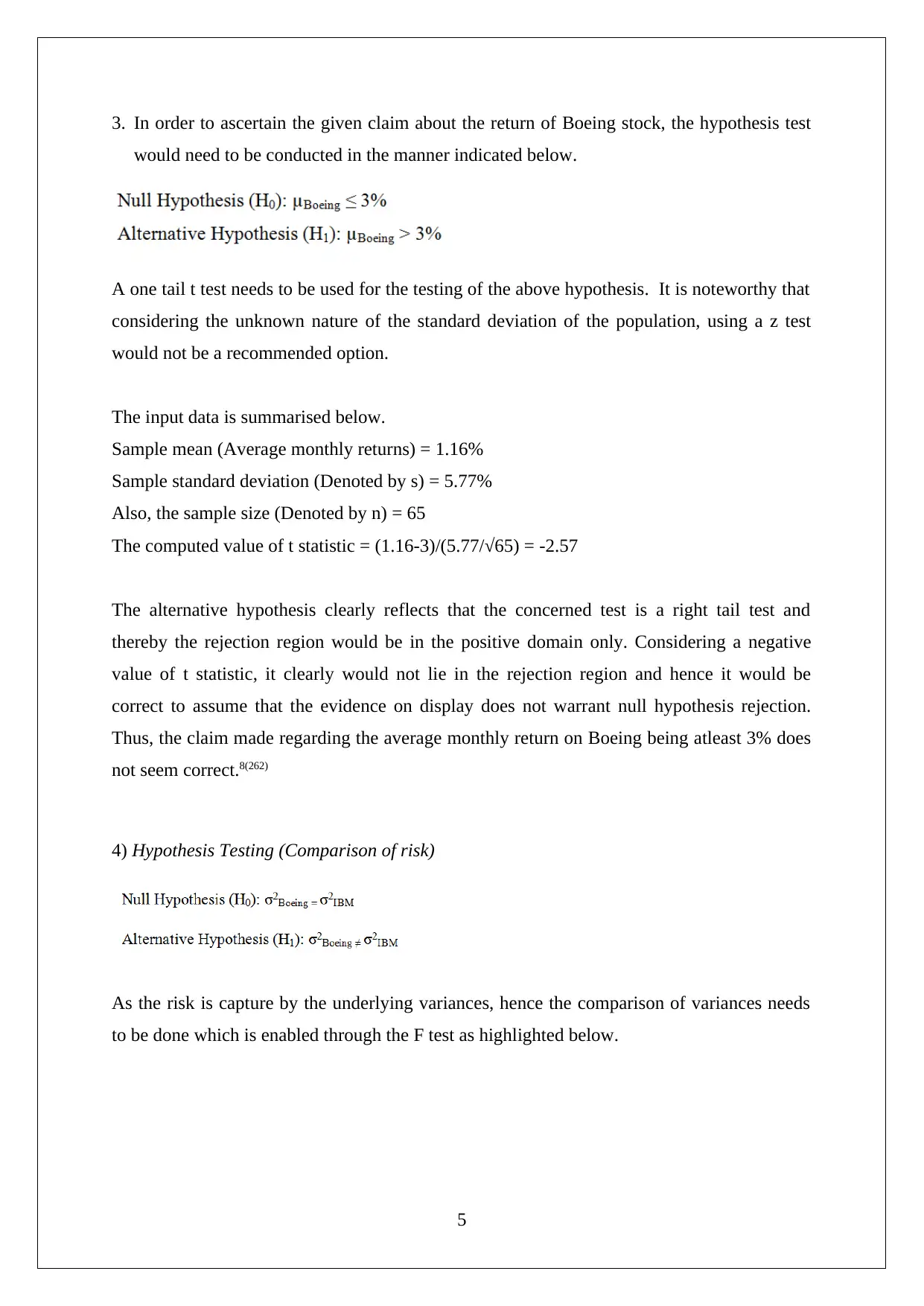
3. In order to ascertain the given claim about the return of Boeing stock, the hypothesis test
would need to be conducted in the manner indicated below.
A one tail t test needs to be used for the testing of the above hypothesis. It is noteworthy that
considering the unknown nature of the standard deviation of the population, using a z test
would not be a recommended option.
The input data is summarised below.
Sample mean (Average monthly returns) = 1.16%
Sample standard deviation (Denoted by s) = 5.77%
Also, the sample size (Denoted by n) = 65
The computed value of t statistic = (1.16-3)/(5.77/√65) = -2.57
The alternative hypothesis clearly reflects that the concerned test is a right tail test and
thereby the rejection region would be in the positive domain only. Considering a negative
value of t statistic, it clearly would not lie in the rejection region and hence it would be
correct to assume that the evidence on display does not warrant null hypothesis rejection.
Thus, the claim made regarding the average monthly return on Boeing being atleast 3% does
not seem correct.8(262)
4) Hypothesis Testing (Comparison of risk)
As the risk is capture by the underlying variances, hence the comparison of variances needs
to be done which is enabled through the F test as highlighted below.
5
would need to be conducted in the manner indicated below.
A one tail t test needs to be used for the testing of the above hypothesis. It is noteworthy that
considering the unknown nature of the standard deviation of the population, using a z test
would not be a recommended option.
The input data is summarised below.
Sample mean (Average monthly returns) = 1.16%
Sample standard deviation (Denoted by s) = 5.77%
Also, the sample size (Denoted by n) = 65
The computed value of t statistic = (1.16-3)/(5.77/√65) = -2.57
The alternative hypothesis clearly reflects that the concerned test is a right tail test and
thereby the rejection region would be in the positive domain only. Considering a negative
value of t statistic, it clearly would not lie in the rejection region and hence it would be
correct to assume that the evidence on display does not warrant null hypothesis rejection.
Thus, the claim made regarding the average monthly return on Boeing being atleast 3% does
not seem correct.8(262)
4) Hypothesis Testing (Comparison of risk)
As the risk is capture by the underlying variances, hence the comparison of variances needs
to be done which is enabled through the F test as highlighted below.
5
⊘ This is a preview!⊘
Do you want full access?
Subscribe today to unlock all pages.

Trusted by 1+ million students worldwide
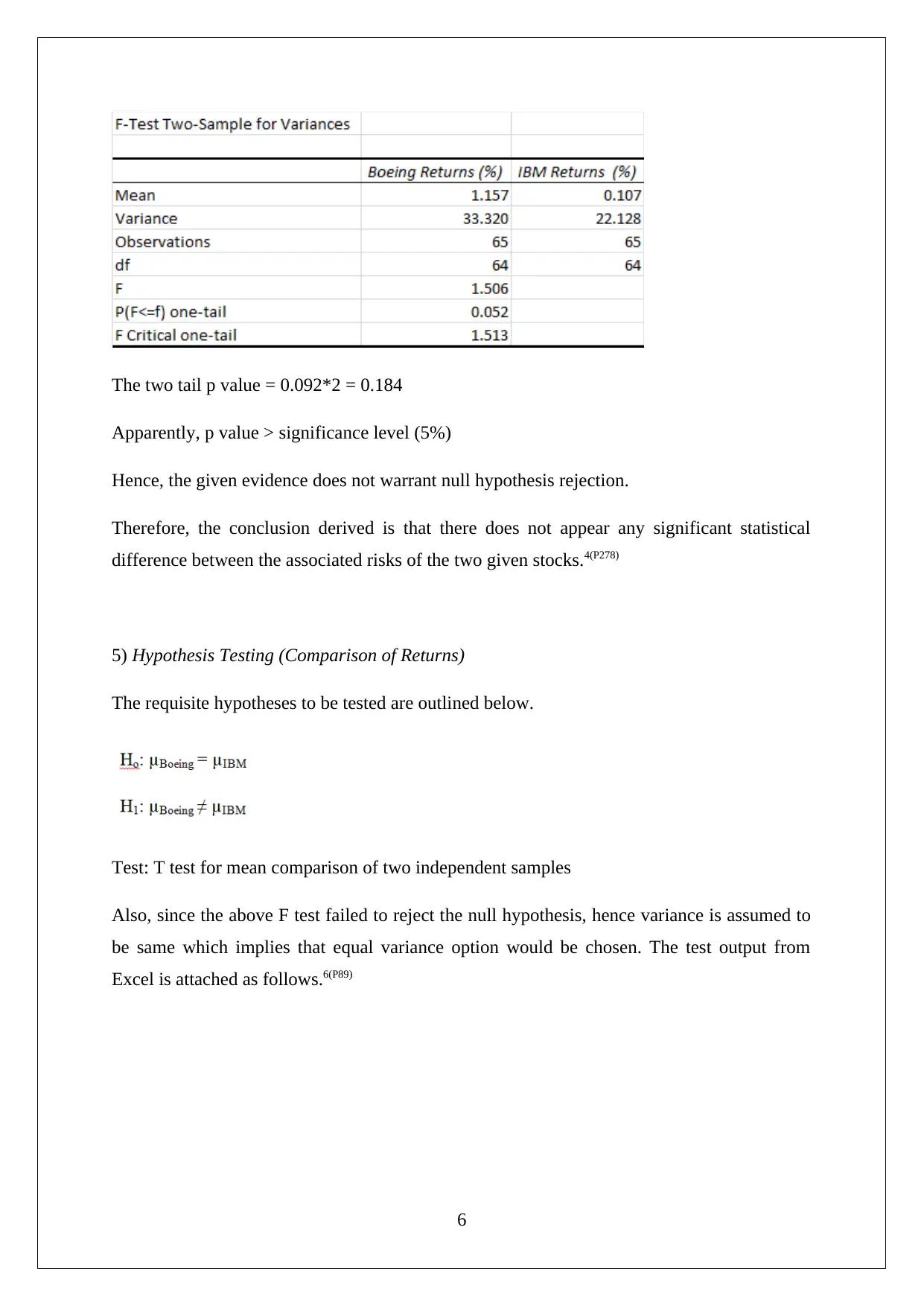
The two tail p value = 0.092*2 = 0.184
Apparently, p value > significance level (5%)
Hence, the given evidence does not warrant null hypothesis rejection.
Therefore, the conclusion derived is that there does not appear any significant statistical
difference between the associated risks of the two given stocks.4(P278)
5) Hypothesis Testing (Comparison of Returns)
The requisite hypotheses to be tested are outlined below.
Test: T test for mean comparison of two independent samples
Also, since the above F test failed to reject the null hypothesis, hence variance is assumed to
be same which implies that equal variance option would be chosen. The test output from
Excel is attached as follows.6(P89)
6
Apparently, p value > significance level (5%)
Hence, the given evidence does not warrant null hypothesis rejection.
Therefore, the conclusion derived is that there does not appear any significant statistical
difference between the associated risks of the two given stocks.4(P278)
5) Hypothesis Testing (Comparison of Returns)
The requisite hypotheses to be tested are outlined below.
Test: T test for mean comparison of two independent samples
Also, since the above F test failed to reject the null hypothesis, hence variance is assumed to
be same which implies that equal variance option would be chosen. The test output from
Excel is attached as follows.6(P89)
6
Paraphrase This Document
Need a fresh take? Get an instant paraphrase of this document with our AI Paraphraser
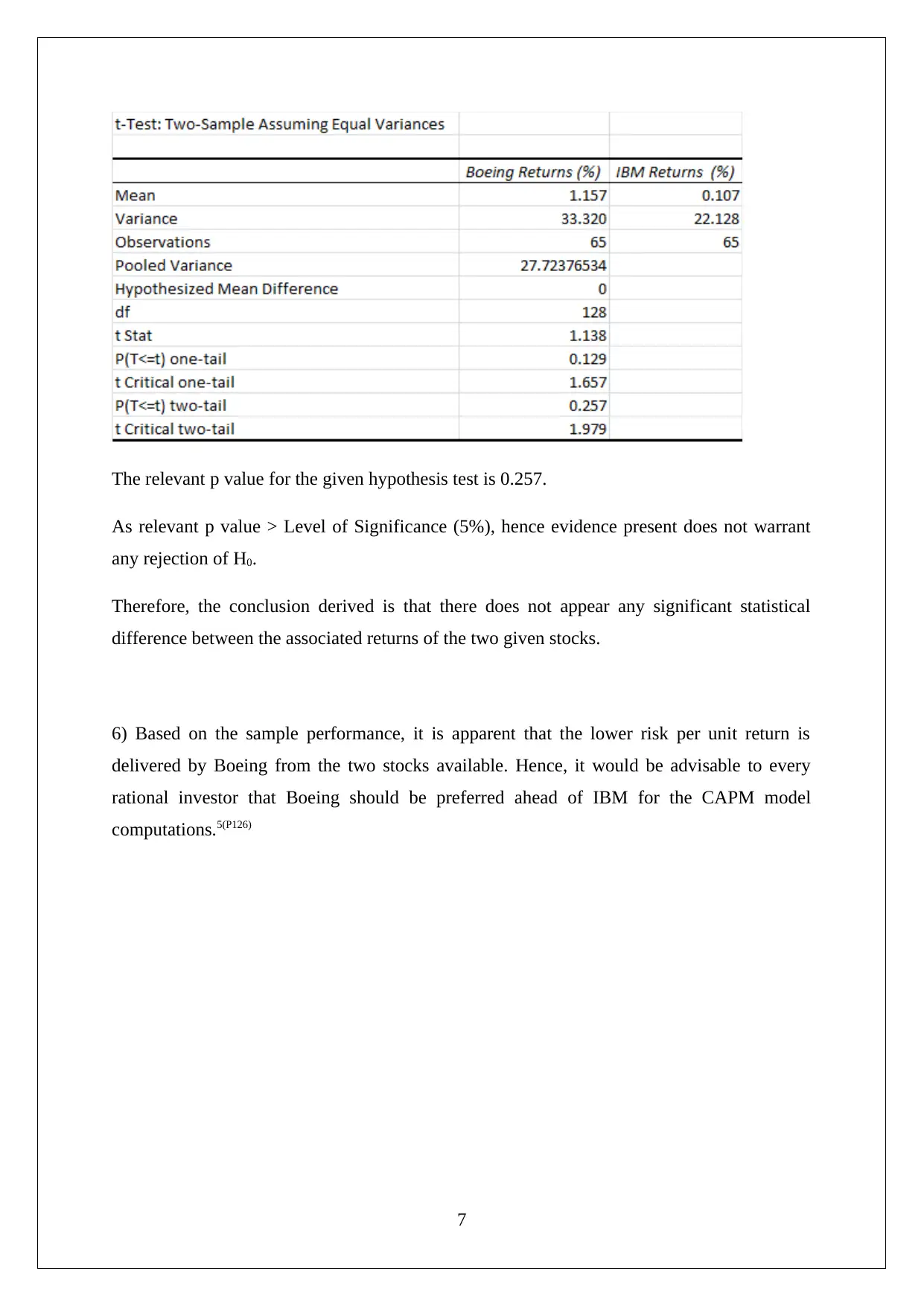
The relevant p value for the given hypothesis test is 0.257.
As relevant p value > Level of Significance (5%), hence evidence present does not warrant
any rejection of H0.
Therefore, the conclusion derived is that there does not appear any significant statistical
difference between the associated returns of the two given stocks.
6) Based on the sample performance, it is apparent that the lower risk per unit return is
delivered by Boeing from the two stocks available. Hence, it would be advisable to every
rational investor that Boeing should be preferred ahead of IBM for the CAPM model
computations.5(P126)
7
As relevant p value > Level of Significance (5%), hence evidence present does not warrant
any rejection of H0.
Therefore, the conclusion derived is that there does not appear any significant statistical
difference between the associated returns of the two given stocks.
6) Based on the sample performance, it is apparent that the lower risk per unit return is
delivered by Boeing from the two stocks available. Hence, it would be advisable to every
rational investor that Boeing should be preferred ahead of IBM for the CAPM model
computations.5(P126)
7
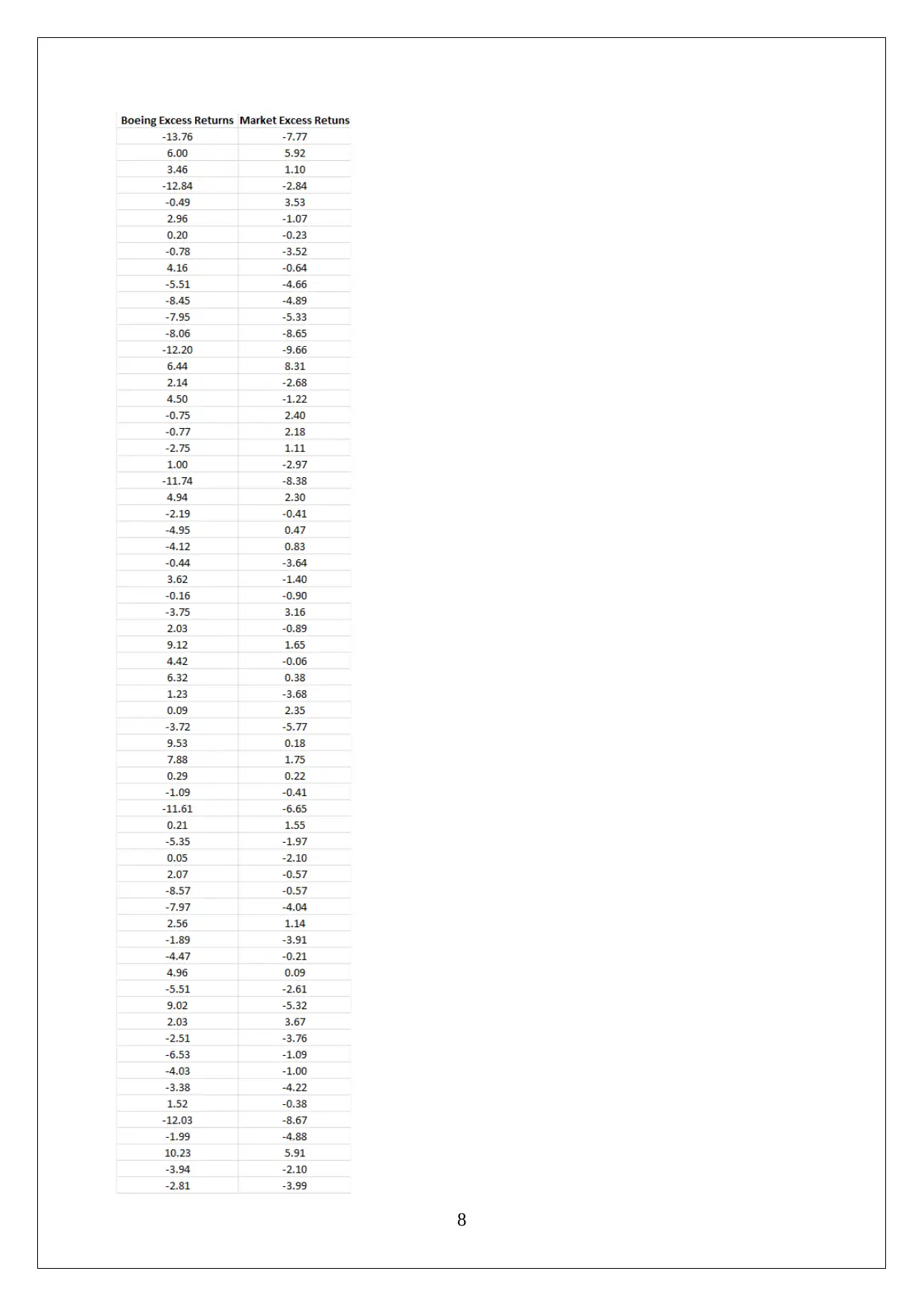
8
⊘ This is a preview!⊘
Do you want full access?
Subscribe today to unlock all pages.

Trusted by 1+ million students worldwide
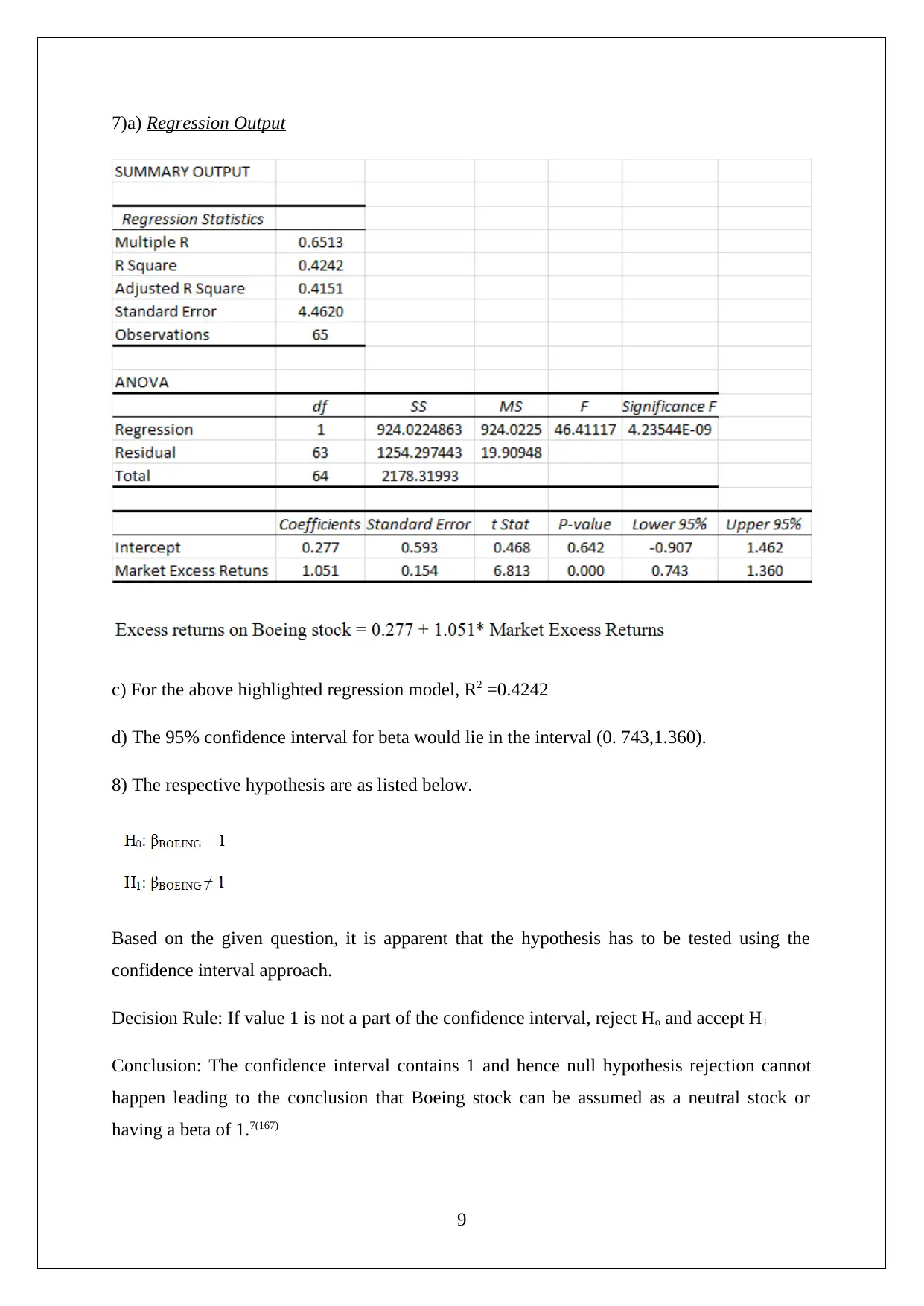
7)a) Regression Output
c) For the above highlighted regression model, R2 =0.4242
d) The 95% confidence interval for beta would lie in the interval (0. 743,1.360).
8) The respective hypothesis are as listed below.
Based on the given question, it is apparent that the hypothesis has to be tested using the
confidence interval approach.
Decision Rule: If value 1 is not a part of the confidence interval, reject Ho and accept H1
Conclusion: The confidence interval contains 1 and hence null hypothesis rejection cannot
happen leading to the conclusion that Boeing stock can be assumed as a neutral stock or
having a beta of 1.7(167)
9
c) For the above highlighted regression model, R2 =0.4242
d) The 95% confidence interval for beta would lie in the interval (0. 743,1.360).
8) The respective hypothesis are as listed below.
Based on the given question, it is apparent that the hypothesis has to be tested using the
confidence interval approach.
Decision Rule: If value 1 is not a part of the confidence interval, reject Ho and accept H1
Conclusion: The confidence interval contains 1 and hence null hypothesis rejection cannot
happen leading to the conclusion that Boeing stock can be assumed as a neutral stock or
having a beta of 1.7(167)
9
Paraphrase This Document
Need a fresh take? Get an instant paraphrase of this document with our AI Paraphraser
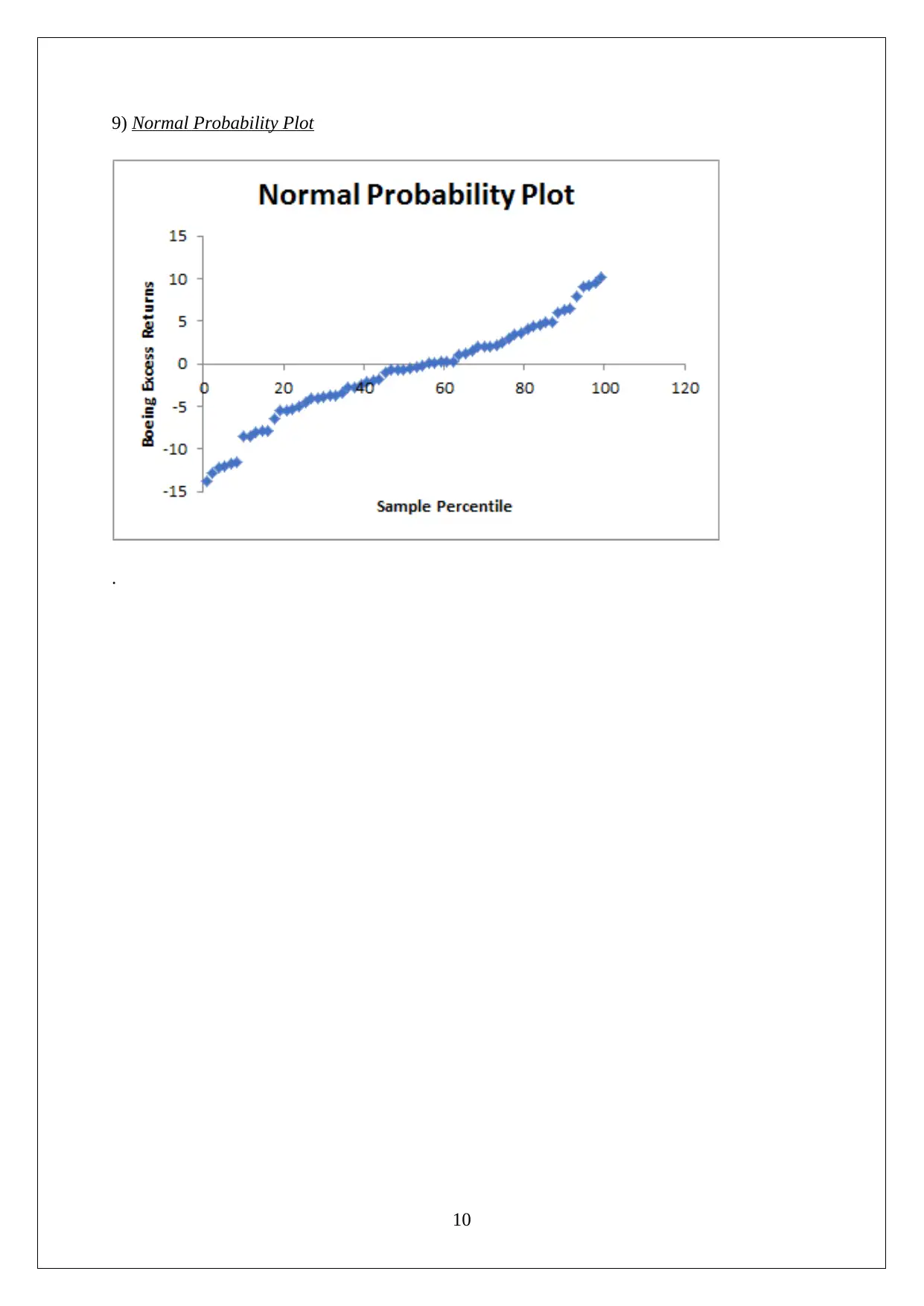
9) Normal Probability Plot
.
10
.
10
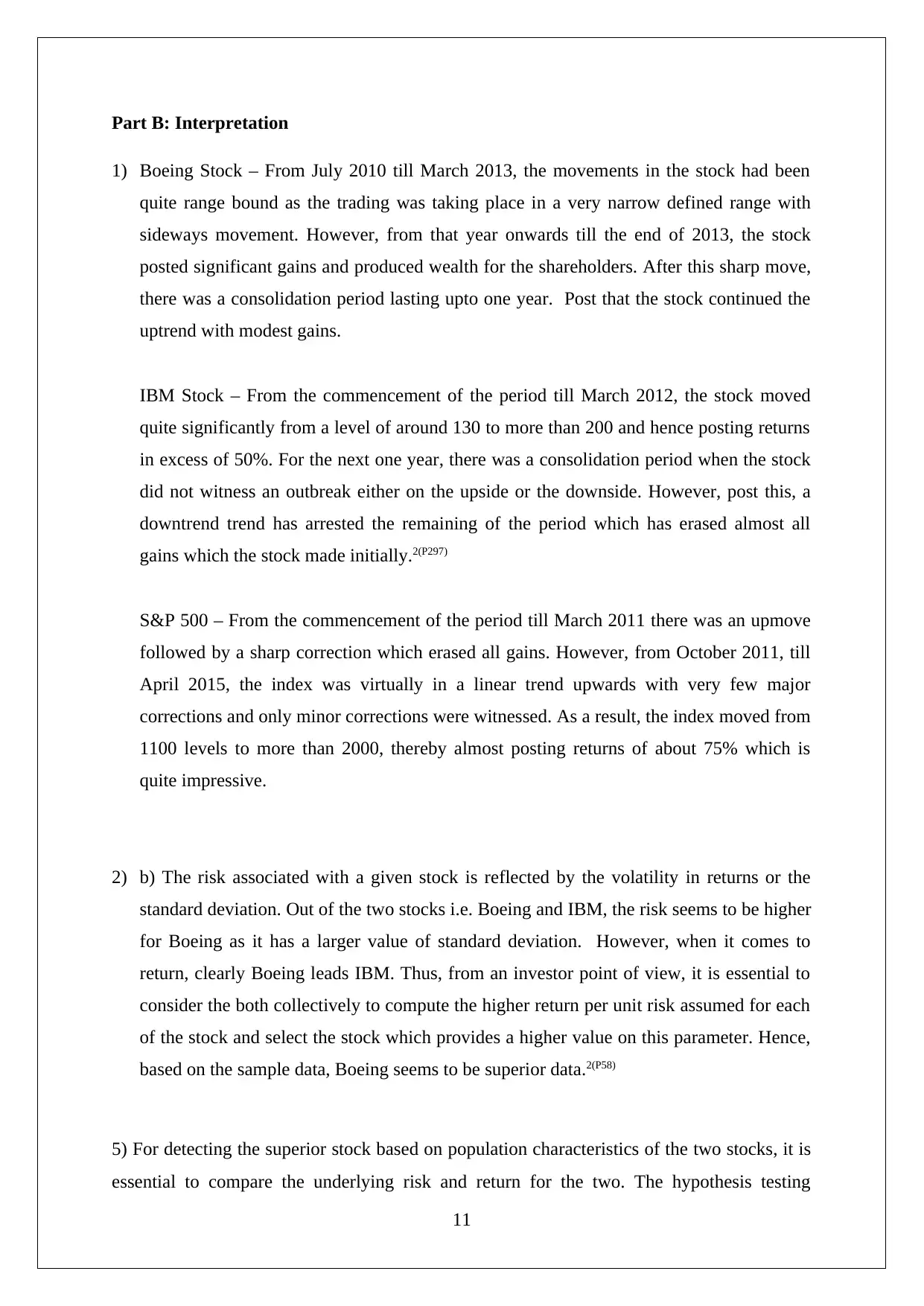
Part B: Interpretation
1) Boeing Stock – From July 2010 till March 2013, the movements in the stock had been
quite range bound as the trading was taking place in a very narrow defined range with
sideways movement. However, from that year onwards till the end of 2013, the stock
posted significant gains and produced wealth for the shareholders. After this sharp move,
there was a consolidation period lasting upto one year. Post that the stock continued the
uptrend with modest gains.
IBM Stock – From the commencement of the period till March 2012, the stock moved
quite significantly from a level of around 130 to more than 200 and hence posting returns
in excess of 50%. For the next one year, there was a consolidation period when the stock
did not witness an outbreak either on the upside or the downside. However, post this, a
downtrend trend has arrested the remaining of the period which has erased almost all
gains which the stock made initially.2(P297)
S&P 500 – From the commencement of the period till March 2011 there was an upmove
followed by a sharp correction which erased all gains. However, from October 2011, till
April 2015, the index was virtually in a linear trend upwards with very few major
corrections and only minor corrections were witnessed. As a result, the index moved from
1100 levels to more than 2000, thereby almost posting returns of about 75% which is
quite impressive.
2) b) The risk associated with a given stock is reflected by the volatility in returns or the
standard deviation. Out of the two stocks i.e. Boeing and IBM, the risk seems to be higher
for Boeing as it has a larger value of standard deviation. However, when it comes to
return, clearly Boeing leads IBM. Thus, from an investor point of view, it is essential to
consider the both collectively to compute the higher return per unit risk assumed for each
of the stock and select the stock which provides a higher value on this parameter. Hence,
based on the sample data, Boeing seems to be superior data.2(P58)
5) For detecting the superior stock based on population characteristics of the two stocks, it is
essential to compare the underlying risk and return for the two. The hypothesis testing
11
1) Boeing Stock – From July 2010 till March 2013, the movements in the stock had been
quite range bound as the trading was taking place in a very narrow defined range with
sideways movement. However, from that year onwards till the end of 2013, the stock
posted significant gains and produced wealth for the shareholders. After this sharp move,
there was a consolidation period lasting upto one year. Post that the stock continued the
uptrend with modest gains.
IBM Stock – From the commencement of the period till March 2012, the stock moved
quite significantly from a level of around 130 to more than 200 and hence posting returns
in excess of 50%. For the next one year, there was a consolidation period when the stock
did not witness an outbreak either on the upside or the downside. However, post this, a
downtrend trend has arrested the remaining of the period which has erased almost all
gains which the stock made initially.2(P297)
S&P 500 – From the commencement of the period till March 2011 there was an upmove
followed by a sharp correction which erased all gains. However, from October 2011, till
April 2015, the index was virtually in a linear trend upwards with very few major
corrections and only minor corrections were witnessed. As a result, the index moved from
1100 levels to more than 2000, thereby almost posting returns of about 75% which is
quite impressive.
2) b) The risk associated with a given stock is reflected by the volatility in returns or the
standard deviation. Out of the two stocks i.e. Boeing and IBM, the risk seems to be higher
for Boeing as it has a larger value of standard deviation. However, when it comes to
return, clearly Boeing leads IBM. Thus, from an investor point of view, it is essential to
consider the both collectively to compute the higher return per unit risk assumed for each
of the stock and select the stock which provides a higher value on this parameter. Hence,
based on the sample data, Boeing seems to be superior data.2(P58)
5) For detecting the superior stock based on population characteristics of the two stocks, it is
essential to compare the underlying risk and return for the two. The hypothesis testing
11
⊘ This is a preview!⊘
Do you want full access?
Subscribe today to unlock all pages.

Trusted by 1+ million students worldwide
1 out of 14
Related Documents
Your All-in-One AI-Powered Toolkit for Academic Success.
+13062052269
info@desklib.com
Available 24*7 on WhatsApp / Email
![[object Object]](/_next/static/media/star-bottom.7253800d.svg)
Unlock your academic potential
Copyright © 2020–2025 A2Z Services. All Rights Reserved. Developed and managed by ZUCOL.




